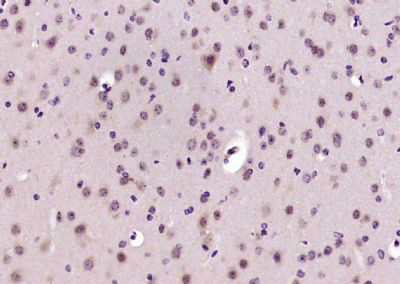产品货号 : mlR6854
英文名称 : CARD7/NALP1
中文名称 : 凋亡加强结构域蛋白7抗体
别 名 : LRR and PYD domains-containing protein 1; CARD 7; CARD7; Caspase recruitment domain protein 7; Caspase recruitment domain-containing protein 7; CLR17.1; Death effector filament forming Ced 4 like apoptosis protein; Death effector filament-forming ced-4-like apoptosis protein; DEFCAP; DEFCAP L/S; NAC alpha/beta/gamma/delta; NAC; NACHT; NACHT leucine rich repeat and PYD containing 1; NACHT leucine rich repeat and PYD pyrin domain containing 1; NACHT leucine rich repeat and pyrin domain containing 1; NACHT LRR and PYD containing protein 1; NALP 1; NALP1; NALP1_HUMAN; NLR family pyrin domain containing 1; NLRP 1; NLRP1; NLRP1 protein; Nucleotide binding domain and caspase recruitment domain; Nucleotide binding oligomerization domain leucine rich repeat and pyrin domain containing 1; Nucleotide-binding domain and caspase recruitment domain; PP 1044; PP1044.
研究领域 : 细胞生物 细胞凋亡
抗体来源 : Rabbit
克隆类型 : Polyclonal
交叉反应 : Human, Mouse, Rat,
产品应用 : ELISA=1:500-1000 IHC-P=1:400-800 IHC-F=1:400-800 IF=1:100-500 (石蜡切片需做抗原修复)
not yet tested in other applications.
optimal dilutions/concentrations should be determined by the end user.
分 子 量 : 162kDa
细胞定位 : 细胞核 细胞浆
性 状 : Lyophilized or Liquid
浓 度 : 1mg/ml
免 疫 原 : KLH conjugated synthetic peptide derived from human CARD7/NALP1:301-400/1473
亚 型 : IgG
纯化方法 : affinity purified by Protein A
储 存 液 : 0.01M TBS(pH7.4) with 1% BSA, 0.03% Proclin300 and 50% Glycerol.
保存条件 : Store at -20 °C for one year. Avoid repeated freeze/thaw cycles. The lyophilized antibody is stable at room temperature for at least one month and for greater than a year when kept at -20°C. When reconstituted in sterile pH 7.4 0.01M PBS or diluent of antibody the antibody is stable for at least two weeks at 2-4 °C.
PubMed : PubMed
产品介绍 : This gene encodes a member of the Ced-4 family of apoptosis proteins. Ced-family members contain a caspase recruitment domain (CARD) and are known to be key mediators of programmed cell death. The encoded protein contains a distinct N-terminal pyrin-like motif, which is possibly involved in protein-protein interactions. This protein interacts strongly with caspase 2 and weakly with caspase 9. Overexpression of this gene was demonstrated to induce apoptosis in cells. Multiple alternatively spliced transcript variants encoding distinct isoforms have been found for this gene, but the biological validity of some variants has not been determined. [provided by RefSeq, Jul 2008].
Function:
Able to form cytoplasmic structures termed death effector filaments. Enhances APAF1 and cytochrome c-dependent activation of pro-caspase-9 and consecutive apoptosis. Stimulates apoptosis through activation of caspase-3. Involved in activation of caspase-1 and caspase-5 as part of the NALP1 inflammasome complex which leads to processing and release of IL1B and IL18. Binds ATP.
Subunit:
Interacts strongly with caspase-2, weakly with caspase-9 and with APAF1 in a cytochrome c-inducible way, leading to the formation of an apoptosome. This interaction may be ATP-dependent. Part of the NALP1 inflammasome complex which is involved in activation of caspase-1 and caspase-5, leading to processing of IL1B and IL18. The complex is activated by bacterial muramyl dipeptide which triggers ATP-binding and oligomerization of NALP1.
Subcellular Location:
Cytoplasm. Nucleus.
Tissue Specificity:
Widely expressed. Isoform 1 and isoform 2 are expressed in peripheral blood leukocytes and chronic myelogenous leukemia cell line K-562, followed by thymus, spleen and heart. Also detected in brain, lung, placenta, small intestine, colon, kidney, liver, muscle, testis and epithelial cells. Absent from hematopoietic progenitor cells but expressed upon differentiation of cells into granulocytes and, to a lesser extent, monocytes. In peripheral blood cells, highest levels are found in T-lymphocytes, granulocytes and monocytes. Expression is significantly increased in bone marrow blast cells of some acute leukemia patients but not in solid tumors.
DISEASE:
Genetic variations in NLRP1 are associated with susceptibility to vitiligo (VTLG) [MIM:193200]. VTLG is a pigmentary disorder of the skin characterized by circumscribed depigmented macules and patches, commonly on extensor aspects of extremities, on the face or neck and in skin folds. It is a progressive disorder in which some or all of the melanocytes in the affected skin are selectively destroyed. It is a multifactorial disorder with a complex etiology probably including autoimmune mechanisms, and is associated with an elevated risk of other autoimmune diseases.
Genetic variations in NLRP1 gene are associated with susceptibility to vitiligo-associated multiple autoimmune disease type 1 (VAMAS1) [MIM:606579]. VAMAS1 is an autoimmune disorder characterized by the association of vitiligo with several autoimmune and autoinflammatory diseases including autoimmune thyroid disease, rheumatoid arthritis and systemic lupus erythematosus.
Similarity:
Belongs to the NLRP family.
Contains 1 CARD domain.
Contains 1 DAPIN domain.
Contains 6 LRR (leucine-rich) repeats.
Contains 1 NACHT domain.
SWISS:
Q9C000
Gene ID:
22861
Important Note:
This product as supplied is intended for research use only, not for use in human, therapeutic or diagnostic applications.
产品图片












